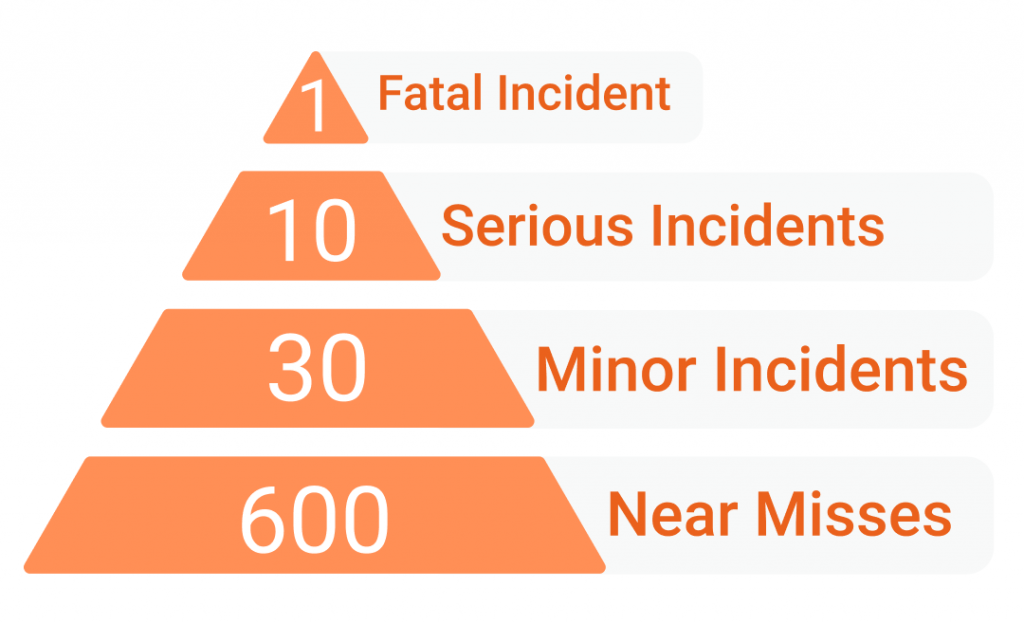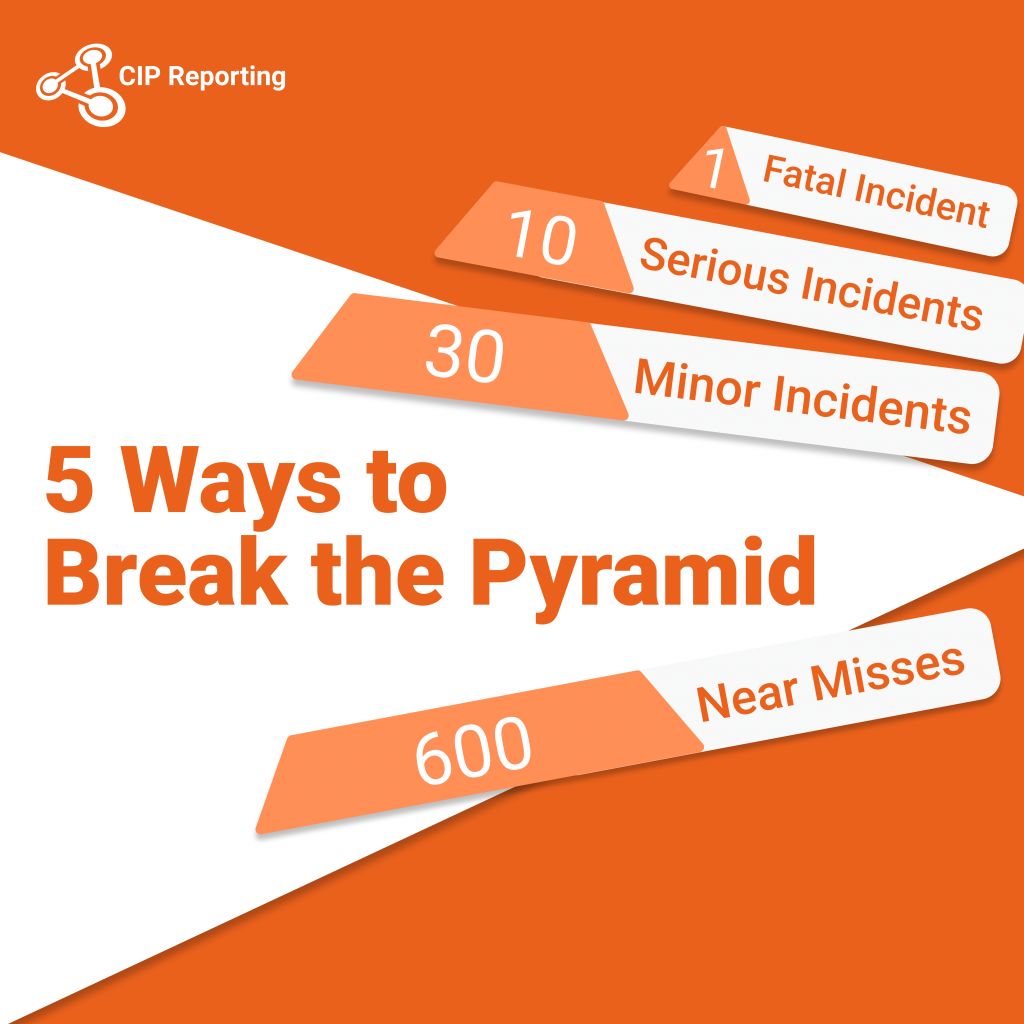We can all identify with the collective “phew” we feel when we know we’ve narrowly avoided a mishap, no matter how minor. For businesses, especially ones with high-risk environments, a close call is much more than a reminder to knock on wood. For hospitals, factories, event spaces, and more, just the possibility of an incident occurring is enough to influence operations. Often referred to as “near miss” events, companies can learn a lot about their exposure to risk from these close calls.
Companies can emphasize the importance of recording and reporting near miss incidents by harkening back to Frank Bird’s “safety pyramid”, a theory that states there is a direct relationship between fatalities, serious accidents (like the ones who got injured in a motorcycle accident), minor accidents, and near misses. The principle has been a tenet of workplace safety practices for decades.

The pyramid shows that for every 600 near misses, there are 30 minor accidents, 10 serious accidents, and one fatality.
#1: Promote a Culture of Reporting
It’s not enough to just provide the tools to make near miss reporting easier (which CIP Reporting can help you with). Encouraging timely and honest reporting starts with company-centered transparency. According to EHS Today, employees don’t report near misses for a variety of reasons, including:
- Fear
- Embarrassment
- Difficulty
- Bureaucracy
- Peer pressure
- Loss of reputation
- Ease of staying silent
- Lack of interest from organization
- Perceived as pointless
Reducing near misses – and thus reducing the risk of accidents and fatalities – is not possible without first addressing why employees would be deterred to report. While it’ll take time for companies to tackle the laundry list of disincentives above, each near miss also provides an opportunity to continue to hone the process. In addition to recording near miss incidents as they arise, take the time to survey the involved employees to get feedback on your reporting procedures and learn the barriers facing your workers.
#2: Refresh Training
It’s only natural that, over time, the particulars of certain protocols and procedures starts to fade in employees’ minds. Even the most experienced and seasoned employees can have a lapse in memory that leads to a near miss. Regular training refreshes may elicit a collective groan from employees but using incidents as opportunities for education doesn’t have to be dull. The key is in your approach.
DO:
- Engage employees with incident simulations
- Reward them for their time
- Ensure training is relevant to employees
DON’T:
- Bore with videos from the 80s
- Schedule trainings immediately after an incident (so as not to indirectly “blame” the employees involved)
- Pander to educated employees
#3: Pinpoint Risk Factors
Despite best efforts to enforce workplace safety and health, incidents – even near misses – are inevitable. Many companies struggle to identify what is truly an accident and what is an indication of a greater issue. With solutions like CIP Reporting, which not only track, but analyze near misses, it can become easier to recognize the factors that led to the incident. Was it employee negligence? Faulty equipment? Bad weather?
Companies can also get to the root of a near miss by:
- Seeking employee feedback
- Comparing it to other events
- Considering the alternative outcomes
- Bringing in an expert
However, companies should be cautioned to avoid jumping to conclusions or creating uncorrelated links between incidents. Relying on software to do the analysis for you helps prevent factors, like confirmation bias, from creating an unreliable risk assessment.
#4: When Necessary, Take Action
Companies have a tricky line to toe when it comes to implementing new procedures for risk avoidance. One misstep in the bureaucratic direction can have employees feeling bogged down with paperwork. And lack of action can provoke feelings of cynicism and create a divide between management and staff. Before change takes place, even small tweaks, companies should know how their employees will react and whether their staff feels the solution is actually addressing the factors that lead to near miss incidents.
In a study conducted by the IMD Business School, researchers found that a few ways organization change fails is due to:
- No clear and compelling case for change
- Insufficient focus on co-creation in design
- Abdication of leadership’s responsibility to drive the process
- Bringing in an expert
Both needless action and deliberate inaction can damage the culture of reporting in your organization. Not every near miss incident requires a change to be made, but it does require your attention.
#5: Collaborate and Communicate
When actions to address near misses become absolutely necessary, solutions need to be crafted in partnership with the employees seeing through the change. Far too often, companies rely on the expertise of outsiders or one-size-fits-all software to implement change. As we learned from the IMD Business School study, organizational change will fail without the contribution of several stakeholders. Creating an open-door environment for confronting near miss developments will also do wonders for nurturing a culture of reporting.
With your plan of action nailed down, communicating the upcoming changes is a crucial step that can’t be skipped. It’s not just the changes that need explaining, but the method in which companies plan to execute, assess, and evolve new near miss procedures. In your communications, be sure to answer these questions:
- Why do we need to change, and why now?
- What is the full extent of the change we need?
- What should improve as a result? How will we measure improvement?
- How does this change link to previous changes?
Near misses are rarely the strokes of good luck felt in the moment. But these close calls can fuel positive and valuable conversations. Getting the right reporting tools in place is half the battle. CIP Reporting solutions are tailored to your industry, your workflow, your challenges, and most importantly, are crafted to promote a culture of reporting, even for small near misses. Don’t hesitate to schedule a free demo today.

